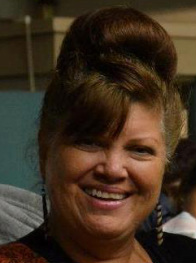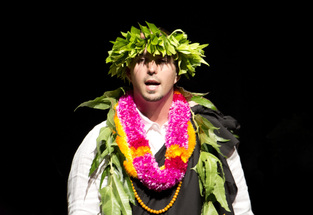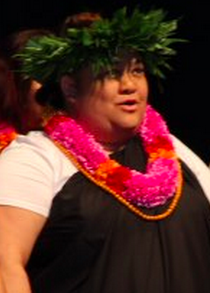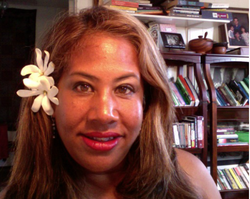AVA Konohiki - Graduates
Kameha'iku Camvel

MA Graduate Hawaiian Studies
Ph.D. Candidate, Political Science
ABSTRACT-
“Land and Genealogy of `Ioleka`a: Mapping an Indigenous Identity
This thesis examines the implications of genealogical connections to blood and place (genealogy and land), as a prerequisite to self-determination and nation building. The identity of self becomes an undertaking grounded by ancestral land tenure and established genealogical connections to the `ili of `Ioleka`a, a kuleana land parcel located in He`e`ia on the island of O`ahu. The kanaka `ōiwi voice is the signifier in this narrative and the discovery of self becomes a mapping project that locates not only a physical place, but the locus of the ancestors who have lived and still reside now on the land. The identity of self is fueled by both tangible and spiritual tenets which provide ancestral wisdom, blood connections, and relation to land as mortar for the kānaka `ōiwi foundation. These are necessary for kānaka `ōiwi well-being, self-determination and by extension, the building of an `Ōiwi Nation.
Ph.D. Candidate, Political Science
ABSTRACT-
“Land and Genealogy of `Ioleka`a: Mapping an Indigenous Identity
This thesis examines the implications of genealogical connections to blood and place (genealogy and land), as a prerequisite to self-determination and nation building. The identity of self becomes an undertaking grounded by ancestral land tenure and established genealogical connections to the `ili of `Ioleka`a, a kuleana land parcel located in He`e`ia on the island of O`ahu. The kanaka `ōiwi voice is the signifier in this narrative and the discovery of self becomes a mapping project that locates not only a physical place, but the locus of the ancestors who have lived and still reside now on the land. The identity of self is fueled by both tangible and spiritual tenets which provide ancestral wisdom, blood connections, and relation to land as mortar for the kānaka `ōiwi foundation. These are necessary for kānaka `ōiwi well-being, self-determination and by extension, the building of an `Ōiwi Nation.
Leon No'eau Peralto

MA Graduate Hawaiian Studies
Ph.D. Candidate, Political Science
I Kama’aina no Makou i ke Kuamo’o: Restoring the Pathways that Define Us
The word “kuamo’o,” can be interpreted as “backbone, spine, trail, path, custom, or way.” Considering these various interpretations of the word, we can thus conceive that “kuamo’o” embodies an idea that our ways of life are networks of trails, which have been established upon our homelands by the many ancestors who came before us. These trails are thus, at once, representative of the backbone of our ancestors, and our own backbone—the core of our being, which defines who we are as Känaka Maoli, past, present, and future. Kuamo’o, trails, and the ways in which they shape, and are shaped by us, is thus the focus of this paper. In particular, this paper focuses on community-based efforts to restore these kuamo’o as pathways towards re-establishing our kuleana (responsibilities) to our kuläiwi (ancestral homelands) in Hāmākua, on the island of Hawai’i. These efforts, initiated by Hui Mālama i ke Ala ‘Ūlili (HuiMAU), a Kānaka Maoli community organization based in Hāmākua, involve making previously inaccessible primary resources of ancestral knowledge available via the internet to rural communities like ours, which are far removed from the archives that house these materials. In doing so, HuiMAU strives to empower our communities to become active researchers and agents of change in addressing the political, social, and environmental issues we now face. It is thus in the restoration of not only physical trails, but also pathways of knowledge, that we fulfill our kuleana to our kulāiwi, our ancestors, and the generations yet to be born.
M.A. Thesis - Website
Ph.D. Candidate, Political Science
I Kama’aina no Makou i ke Kuamo’o: Restoring the Pathways that Define Us
The word “kuamo’o,” can be interpreted as “backbone, spine, trail, path, custom, or way.” Considering these various interpretations of the word, we can thus conceive that “kuamo’o” embodies an idea that our ways of life are networks of trails, which have been established upon our homelands by the many ancestors who came before us. These trails are thus, at once, representative of the backbone of our ancestors, and our own backbone—the core of our being, which defines who we are as Känaka Maoli, past, present, and future. Kuamo’o, trails, and the ways in which they shape, and are shaped by us, is thus the focus of this paper. In particular, this paper focuses on community-based efforts to restore these kuamo’o as pathways towards re-establishing our kuleana (responsibilities) to our kuläiwi (ancestral homelands) in Hāmākua, on the island of Hawai’i. These efforts, initiated by Hui Mālama i ke Ala ‘Ūlili (HuiMAU), a Kānaka Maoli community organization based in Hāmākua, involve making previously inaccessible primary resources of ancestral knowledge available via the internet to rural communities like ours, which are far removed from the archives that house these materials. In doing so, HuiMAU strives to empower our communities to become active researchers and agents of change in addressing the political, social, and environmental issues we now face. It is thus in the restoration of not only physical trails, but also pathways of knowledge, that we fulfill our kuleana to our kulāiwi, our ancestors, and the generations yet to be born.
M.A. Thesis - Website
Kulani Jeremiah-Wong

NĀ PALAPALA ʻĀINA I LOKO O NĀ MELE
Mae Paiekulani Mahinaarangi Jeremiah-Wong
Kahuku, Koʻolauloa, Oʻahu
This thesis is about Hawaiian land and how the ancestors used songs to create an intellectual map of the Hawaiian Islands. It alsoIt is a llooks at the mapping of our ‘āina well before any newcomers Westerners arrived and before the knowledge of our land was put onto paper. Before the desire to place instrument to paper and leave a lasting imprint, there were mele. This thesis is a view into the past, the present and the future of mele wahi pana mainly, needed to be done in order for another Hawaiians describing the land to contribute to the ancestral knowledge well.
Mae Paiekulani Mahinaarangi Jeremiah-Wong
Kahuku, Koʻolauloa, Oʻahu
This thesis is about Hawaiian land and how the ancestors used songs to create an intellectual map of the Hawaiian Islands. It alsoIt is a llooks at the mapping of our ‘āina well before any newcomers Westerners arrived and before the knowledge of our land was put onto paper. Before the desire to place instrument to paper and leave a lasting imprint, there were mele. This thesis is a view into the past, the present and the future of mele wahi pana mainly, needed to be done in order for another Hawaiians describing the land to contribute to the ancestral knowledge well.
Ka'ahiki Solis


